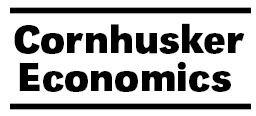Agricultural Economics, Department of

Cornhusker Economics
Date of this Version
2014
Document Type
Newsletter Issue
Citation
CORNHUSKER ECONOMICS, University of Nebraska-Lincoln Extension, April 16, 2014
Abstract
Retail beef prices have continued to rise over the last several years (Figure 1, next page). They hit a record high in February 2014, with choice-beef prices selling for an average of $5.57 per pound, 7.6 percent more than a year ago. Average all-fresh beef sold for $5.28 per pound, more than 7.5 percent over the previous year. Compared to February 2010, choice beef prices have risen by 33.2 percent and all-fresh beef by 34.7 percent. Beef prices have nearly doubled since the year 2000. “Why are we seeing record high prices?” and “How have these prices been impacted by inflation?” First, we can analyze how these prices have been impacted by inflation over the last several years. Figure 1 shows real “beef prices” adjusted for inflation (put in the year 2000 dollars). Real beef prices still trend upwards, but not to the extent that nominal prices are trending. Real retail choice beef prices are up 15.2 percent, and real all-fresh beef prices are up 18.5 percent since the base year. During 2014, prices have continued to climb. The rise is partly due to a reduction in supply. The inventory of all cattle and calves are currently at historical lows; less animals equals less pounds of beef available. With the tighter supplies and higher prices, some may automatically assume demand will wane. However, the decline in supplies may cause higher prices, but those higher prices do not necessarily mean a reduction in demand. It is important to understand what demand really is, and to understand the main drivers of that demand before determining how the higher prices might impact the demand for beef.


Comments
Copyright 2014 University of Nebraska